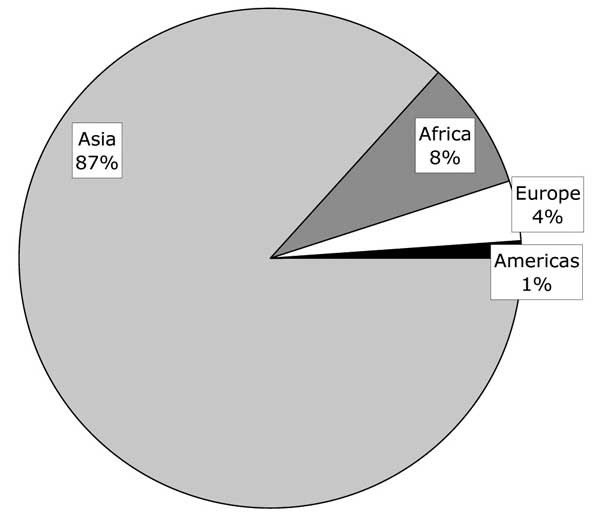of women in agriculture is falling, the relative share is rising, i.e., women make up an increasing fraction of the labor force in agriculture, especially in sub-Saharan Africa where hoe agriculture is practiced extensively (Spieldoch, 2007). While the agrifood sector in toto may still account for a large portion of national economies, with the production of inputs, industrial transformation and marketing of food, and transport becoming more important in terms of value and employment, agricultural production itself accounts for a diminishing share of the economy in many countries while the other sectors are expanding. Average farm sizes vary greatly by region (see Table 1-2).
Trade and the agricultural sector
International trade and economic policies can have positive and negative effects on different development and sustainability goals. In addition, AKST can have substantial roles in the formation of better policies. Poverty-affected agricultural producers in particular have been poorly served by trade; unless they have better access to efficient and equitable market systems, they cannot easily benefit from AKST initiatives (IFAD, 2003). Trade policies and market dynamics are thus key determinants of whether and how AKST systems can effectively address poverty, hunger, rural livelihoods and environmental sustainability. Although most agricultural production is not traded internationally, national agricultural planning and AKST investment is increasingly oriented towards export markets and designed to comply with international trade rules. Agricultural trade has been increasing in developing country regions particularly since the 1970s (FAO, 2005a).
The focus on export has left many small-scale producers, i.e., the majority of the rural poor, vulnerable to volatile international market conditions and international competition, often from subsidized producers in the North. The globalization of agriculture has been accompanied by concentration of market power away from producers into the hands of a limited number of large-scale trade and retail agribusiness companies. Corporate concentration along the agrifood value chain can have a significant impact on international commodity prices, which have recently risen but have generally been low relative to industrial and manufactured goods (FAO, 2005a). In addition, increased international trade in agricultural commodities has often led to overexploitation of natural resources, and increased energy use and greenhouse gas (GHG) emissions. Overall the impact of trade liberalization has been uneven in industrialized and developing countries.
Table 1-2. Approximate farm size by world region.
| World region | Average farm size, ha |
|---|---|
| Africa | 1.6 |
| Asia | 1.6 |
| Latin America and Caribbean | 67.0 |
| Europe* | 27.0 |
| North America | 121.0 |
Source: Nagayets, 2005; von Braun, 2005.
*data includes Western Europe only.
Small-scale farming as a particular challenge for agriculture.
Despite the crucial role that agriculture has for rural populations in transition and developing countries, agriculturebased livelihoods and rural communities are endangered by poverty worldwide. Based on FAO census data, it has been estimated that about 525 million farms exist worldwide, providing a livelihood for about 40% of the world's population. Nearly 90% of these are small farms defined as having less than two hectares of land (see e.g., Nagayets, 2005). Small farms occupy about 60% of the arable land worldwide and contribute substantially to global farm production (Figure 1-3). In Africa, 90% of agricultural production is derived from small farms (Spencer, 2002). If a high percentage of a country's population is engaged in agriculture and derives its livelihood from small-scale farming, the whole sector is predominantly subsistence-oriented, which makes livelihoods extremely vulnerable to changes in direct drivers such as diseases, pests, or climate, even though its sensitivity to indirect drivers such as markets, infrastructure and external inputs is less pronounced. Not surprisingly, subsistence farmers tend to be very aware of their multiple vulnerabilities and therefore adopt diverse risk-minimizing and mitigating strategies.
Poorly developed market infrastructure such as rural roads and postharvest facilities are among the factors that have limited market access for outputs and inputs (e.g., fertilizer) for the majority of small-scale farmers (FAO, 2005a) (Figure 1-4).
Growing disparities have developed over the last 50 years between small-scale farming that follows local practices and industrial agricultural systems that have incorporated formal AKST. A key factor is the tremendous increase in labor productivity in industrialized agriculture and the stagnating labor productivity in most small-scale systems

Figure 1-3. Regional distribution of small-scale farms. Source: Nagayets, 2005 based on FAO 2001c, 2004c and national statistical agencies.
Note: Small-scale farms are defined as those of less than 2 hectares. The total number of small-scale farms is 404 million.